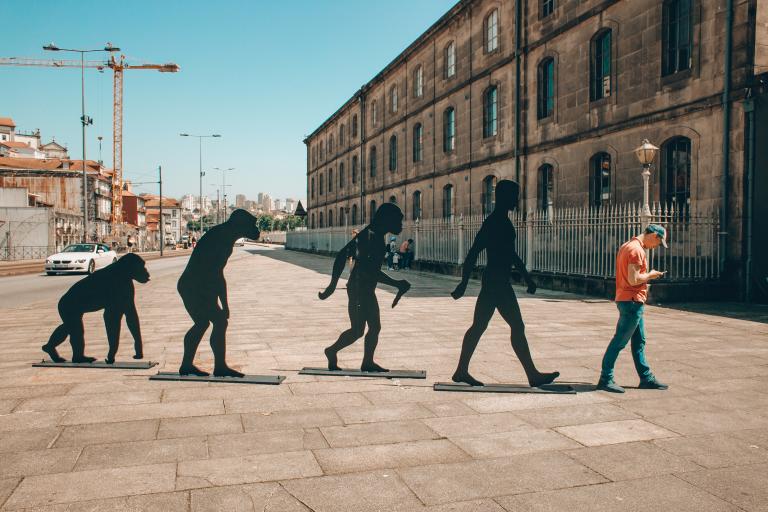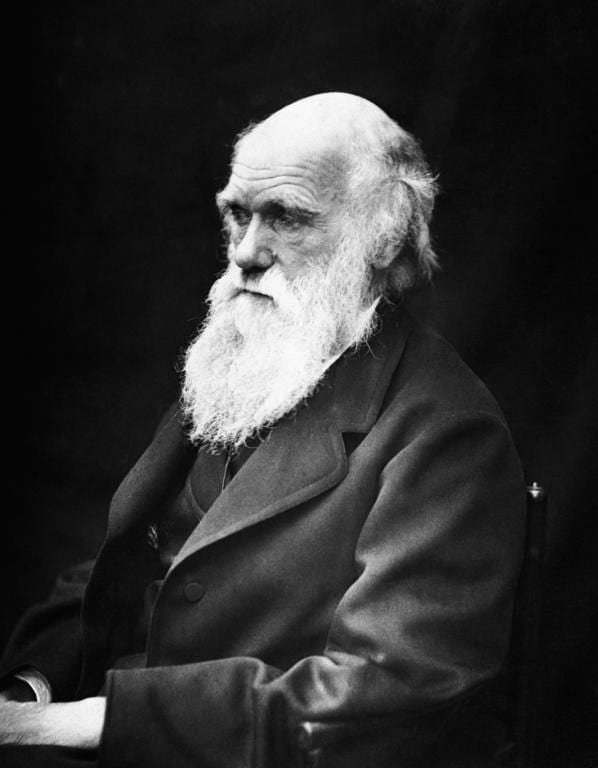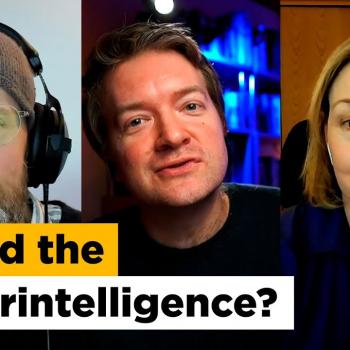
In light of a recent debate on evolutionary theory, Erik Strandness explains why he changed his mind about how we should put science and faith together. (Look out for a response article from Joshua Swamidass, coming soon.)
Michael Behe, the godfather of intelligent design (ID) theory, was recently in conversation with computational biologist and physician Joshua Swamidass. On Unbelievable? they discussed the history of intelligent design and how it continues to be a controversial topic in scientific and theological circles.
It was a wide-ranging conversation, but the part I found most compelling was the discussion about the strengths and limitations of theistic evolution and intelligent design as vehicles to unite faith and science. Swamidass doesn’t label himself a theistic evolutionist, but he seems to share its favorable stance towards evolution and its opposition to intelligent design.
Swamidass was raised a young earth creationist but was eventually convinced by his scientific work that evolutionary science offered the best explanation of human origins. He had some agonizing moments as he contemplated the potential family and career repercussions that would ensue once he made his views known but bravely went forth and published an op-ed in the Wall Street Journal outlining his stance. He recounts the details of this journey in a recent blog which I would encourage everyone to read.
Cold War
I was raised in the Lutheran church and have always had a place for God in my life, but that was exactly my problem: I had a place for God in my life. I had foolishly built a cute little bungalow on my personal property for the almighty God of the universe to dwell in when in reality, I was just lucky to live in a mud hut in His Kingdom.
Part of the reason I compartmentalized my faith was because I was a science guy and science told me I was just an evolved chemical. I, like many of my medical colleagues, uncritically accepted evolutionary theory and failed to see our hypocrisy as we did very un-evolutionary things like caring for extremely premature babies on the edge of viability and repairing infants with congenital birth defects.
I felt that my faith was important, but instead of reconciling the two, I adopted Stephen J. Gould’s concept of non-overlapping magisteria (NOMA), where religion and science are acknowledged as sovereign powers but never allowed to establish embassies within each other’s borders. Unfortunately, rather than creating a warm sensation of peace, I shivered with cognitive dissonance at the thought of a magisterial cold war where I knew that at any minute one side or the other could push the red button and transform my life into a mushroom cloud of despair. I realized I could no longer just hide under my desk every time a mental alarm went off, but had to pursue détente or risk mutually assured destruction.
Intellectually fulfilled Christian
As I struggled with my warring magisteria, I came across a scripture passage that I had read many times before, but which took on a deeper meaning:
“For what can be known about God is plain to them, because God has shown it to them. For his invisible attributes, namely, his eternal power and divine nature, have been clearly perceived, ever since the creation of the world, in the things that have been made. So they are without excuse.” (Romans 1:19-20)
I finally realized that I lived in God’s world, He didn’t live in mine. God had created a world where everything that “had been made” was designed to reveal to “his eternal power and divine nature”. Science was Theology!
God wasn’t just a divine being who slapped my hands when I stuck them in the cookie jar, but was the Creator of a scientific candy shop where I was free to feel like a kid. Scales fell from my eyes and I was able to see how every scientific discovery uncovered one more of God’s thoughts.
As I explored the various ways scientists had tried to combine science and faith, I realized that the only one that allowed me to truly “perceive” God’s “eternal power and divine nature” in the “things that had been made” was ID. I realized that if I lived in God’s world, the evidence for His handiwork should be everywhere. He built it and sustains it, so the problem hadn’t been a lack of evidence but rather my inability to adequately perceive it.
Richard Dawkins famously said that Charles Darwin made it possible for him to be an intellectually fulfilled atheist, but I found that ID made it possible for me to be an intellectually fulfilled Christian.

Silencing the Stones
As a physician, I found it quite disconcerting that academia had not only attempted to silence the voices of scientists that recognized a Designer, but also had the chutzpah to muzzle nature itself. Uncomfortable when they heard the “heavens declare”, they jumped up to the podium, became nature’s press secretary and put a materialistic spin on every transcendent question the human press corps brought to their attention. Asked to respond to rumors of a Signature in The Cell they told us that their organization had been hacked by Christian terrorists trying to introduce a ghost into the biological machine.
Materialists ended up becoming cruel task masters who instructed nature to speak only when spoken to. And when confronted by obnoxious stones that cried out, they were forced to use their inside laboratory voices. Personally, if I didn’t hear God speak in the intricate design of the world, I would have to conclude that His existence was just wishful thinking.
Truce or Reunification?
Both Swamidass and Behe admirably want to bring science and faith together. The issue is not their noble intentions, but the apologetic tools they employ. Theistic evolutionists encourage Christians to listen to what evolution has to say, while ID counters that evolution is nothing but biological babble and, instead, offer a God who eloquently speaks His mind.
Theistic evolutionists get science and faith together in the same room but can’t seem to overcome the awkward silence that results from having so little in common. ID, however, creates a successful meet and greet because the Language of God makes for great conversation.

Being Alone Together
It appears that Swamidass is more comfortable with a NOMA situation, where theology tells us about God and science tells us about the material world. He said:
“I am a Christian and I make sense of the world really through theology more than I do through science.”
If Neo-Darwinian theory is good enough for the atheist and theist alike, then science is irrelevant to apologetics. It admirably allows atheists and Christians to work side-by-side in the lab, but sadly leaves God out in the cold peering through the laboratory window.
I think part of the reason that theistic evolutionists are comfortable working in science is because their faith doesn’t threaten the scientific materialism of their colleagues. Faith ends up looking like a helpful spiritual add-on to science rather than the foundation of the whole enterprise. The problem with an add-on faith is that it can just as easily be lopped off.
If we don’t see God physically present in a world which He called “very good” then I think our arguments for Christianity get reduced to a transcendent “burning in the bosom”. God is not hidden in the scientific shadows of ignorance but is “the light by which we see everything else”.
I don’t believe just giving a scientist permission to believe in God is an adequate apologetic. While Swamidass’ goal is admirably to harmonize Christianity and science, I feel like all he has really done is say it’s OK to live with the tension.
Rorschach or Book of Nature?
Interestingly, many theistic evolutionists don’t find God under the microscope but do in the courtroom. It appears they are more convinced of God’s existence by the moral argument than the scientific argument.
I’m glad that they find assurance for their faith in this minimalist approach, but it leaves a huge chasm between an awe-inspiring Big Bang and the appearance of morality and consciousness in human beings. A gap which they fill with a rather bland series of naturally selected mutations.
They give God credit for the big-ticket items, but don’t want to bother Him with the mundane task of speciation. Sadly, they reduce the book of nature to a Rorschach ink blot that offers us a vague psychological rendering of God’s subconscious rather than fine biological literature that reveals the sharpness of His mind.

Imitation is the Sincerest Form of Flattery
In the Unbelievable? debate Swamidass said:
“God was involved in the rise of humans but I don’t actually see any biochemical evidence of God’s design there.”
I have to respectfully disagree with him because I treat my patients based on an irreducibly complex physiological template that I didn’t create, but which I dismiss at my own peril. I’m able to successfully practice medicine because my patients are fearfully and wonderfully made, not because they were naturally selected to survive.
Interestingly, a whole field of science called biomimetics has emerged that takes the superior design of irreducibly complex biological machines and tries to replicate them at the macro level. It appears that rather than dismissing design, science is beginning to imitate it as the sincerest form of divine flattery.
Swamidass made the case that biological machines are not machines in the traditional sense. However, I think he would get some push back from the biomimeticists who know that nature has given them a template for a better mousetrap, which, if successfully replicated, will inspire the world to beat a path to their door.
Scientific parables
Swamidass suggested Christians shouldn’t presuppose that we can see evidence of God’s mind in the world because in the end, He is beyond knowing:
“God providentially governs all things…but we don’t know how he does this unless He tells us…That’s the orthodox Christian position.”
While there is a significant difference between Creator and created, we have been made in His image, which should at least give us a clue as to what He was thinking. God’s thoughts are higher than ours, but he also made some of them known to us when He physically spoke them into existence. A God who teaches us through parables of vines, wheat, seeds and sheep surely likes to speak to us through proteins and nucleotides.
Lion Lies Down with Lamb
I’m afraid that theistic evolution tries to unite science and faith by reintroducing Stephen J. Gould’s non-overlapping magisteria. But what if the magisteria actually overlapped? What if a speaking God recited a DNA code?
What if a God who told the oceans “thus far and no further” established laws of gravitation? What if a God who said “let there be light” gave it a specific speed? What if the God who “weighed the mountains on the scales and the hills in a balance” created tectonic plates? What if the biological writing is on the wall? Do we treat it as if it is human graffiti or the work of the finger of God?
Clothed in Christ, we shouldn’t put God on a hanger when we don our laboratory coat. If science and faith aren’t able to join hands and make their way from the academic bench to the bedside of a world that is physically and spiritually dying, then they will have both failed at their most important task.
The good news is that theistic evolutionists and intelligent designers both worship a God who died for their sins. And, while we may differ about the scientific details, we know that we will all get together in the new heaven and earth for the ultimate scientific conference where the featured speaker will be God Himself.
My hope is that one-day the lion of science will lie down with the Lamb of God. The scientific journal will be on the same bedside as the Bible. Until that day comes, we need more conversations like the one between Swamidass and Behe on Unbelievable?.
Listen to Michael Behe and Joshua Swamidass discuss intelligent design













